Everyone loves a good party, and the energetic, free-wheelin’ fun of craft beer helps brewers throw some of the best. But putting on an event at your brewpub, tasting room or brewery means more than just having a good time. An event is a chance to build your brand and expand your customer base, while introducing craft beer fans to your new brews.
Take Blue Mountain Brewery, located in Afton, Va., for example. The brewery vaulted away a special reserve batch — Dark Hollow Reserve, a bourbon barrel-aged imperial stout, aptly named Concealed Darkness — for 12-months, and now the Blue Mountain Barrel House is planning a big event to release this beer as an on-premise-only beer. While busy planning out all the details, Joseph Beck, brewer at Blue Mountain Brewery, took some time to share his insight into what goes into the event planning and what the brewery hopes to see in return.
(Note: Don’t miss the “After” story when we catch up with Blue Mountain Brewery for a party post-mortem.)
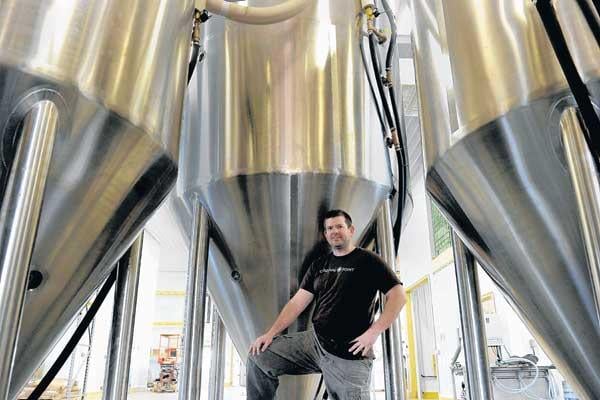
Craft Brewing Business (CBB): Before we get into the event details, it sounds like the brewery has expanded quite a bit since summer 2012. Expansion is an issue that many craft brewers are dealing with—can you give us a little more detail on how you handled it?
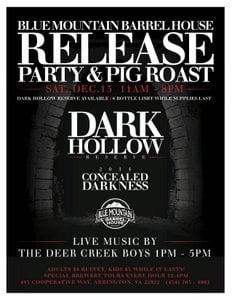 Beck: We have expanded quite a bit since opening the Blue Mountain Barrel House in 2012, and this brewery is itself an expansion from our original brewpub that opened in 2007. The original Blue Mountain Brewery used to be the sole source of packaged and distributed beer and had a capacity of about 2,500 bbls/year. When we opened Barrel House it added 4,000 bbls/yr to that number, focused heavily on our high-gravity and barrel-aged offerings. The brewery was built around the barrel-aging process. Fast-forward to 2014, and we’re pacing about 9,000 bbls/yr with current capacity of 14,000 bbls/yr. We’ve added a variety of cellar tanks (60, 90 and 120 bbl fermenters and brite tanks) and packaging upgrades (wild goose canning line) to achieve this new volume potential. Our brew house is a one of a kind design built by Taylor Smack and Premier Stainless engineers. Premier Stainless supplied all fermentation and brite tanks other than the120bbl tanks provided by Craftwerk
Beck: We have expanded quite a bit since opening the Blue Mountain Barrel House in 2012, and this brewery is itself an expansion from our original brewpub that opened in 2007. The original Blue Mountain Brewery used to be the sole source of packaged and distributed beer and had a capacity of about 2,500 bbls/year. When we opened Barrel House it added 4,000 bbls/yr to that number, focused heavily on our high-gravity and barrel-aged offerings. The brewery was built around the barrel-aging process. Fast-forward to 2014, and we’re pacing about 9,000 bbls/yr with current capacity of 14,000 bbls/yr. We’ve added a variety of cellar tanks (60, 90 and 120 bbl fermenters and brite tanks) and packaging upgrades (wild goose canning line) to achieve this new volume potential. Our brew house is a one of a kind design built by Taylor Smack and Premier Stainless engineers. Premier Stainless supplied all fermentation and brite tanks other than the120bbl tanks provided by Craftwerk
Our initial packaging equipment consisted of a Cask, two-head filler system. We have since then upgraded to a Wild Goose Canning Line. We also have plans in the near-term future on investing in a Mono-Block 12 head filler (3,000 12-ounce bottles an hour) that will retire our current 2007 Edition Maheen six-head filler bottler.
I think that it is also important to touch on our close knit team. We have carefully recruited employees locally — not once have we sourced an individual from out of state to assist us in the growth of the company. We have taken pride in a hire locally, train and promote-within mentality. We also have employed three veterans, myself included.
CBB: Where did the Dark Hollow Reserve idea come from? Twelve months is a long time to age a beer; did the beer inspire the event or did the need to do a cool holiday event inspire the beer?
Beck: Hands down, the beer inspired the event. We hit the ground running with production when the doors opened in July 2012 and focused on keeping our patrons quenched with our beer. We allocated time the second year to brew the reserve batch so that we could tuck it away for 12-months to condition in American White Oak bourbon barrels. We doubled our certain specialty malts in this brew and tripled the aging time to ensure that we can justifiably use the term “Reserve.” Barrel-aging this spectacular Imperial Stout for 12-months created a harmony of complex flavor and aroma. We krausened and bottled only two thousand 750ml cork and caged-style bottles and have them conditioning in our cellar.
I asked Taylor Smack, brewmaster, for perspective on barrel-aging and a little of the origins of the beer we built this event around. Here’s what he had to say:
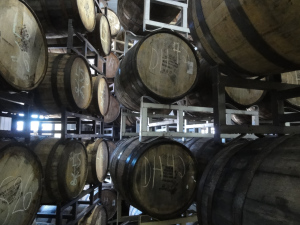 Smack: When Mandi [Smack’s wife], Matt Nucci, co-owner, and I founded Blue Mountain Brewery in 2007, Dark Hollow, our bourbon barrel-aged beer was on the docket from the beginning. The first batch came out around Christmas 2007. I felt, and still feel, like bourbon barrel-aging is a distinct part of my personal brewing heritage. It’s become standard now, but for a short time in 2000 and 2001, there were only a handful of brewers anywhere in the world aging beer in bourbon barrels, and to my knowledge, the only folks doing it were members of the Illinois Craft Brewers Guild, along with, I think, 3 Floyds Brewing Co. in Indiana. Big players were folks like Todd Ashman at Flossmoor Station and Pete Crowley at Rock Bottom. Goose Island’s Greg Hall had “invented” this method in the mid-’90s, and for a good while, Goose Island’s Bourbon County Stout was all there was. It was and is the hallmark of the style. We brewed it only at the Clybourn Ave. Goose Island brewpub during my time there; it was just Matty Kemp [now at Revolution] and me brewing 10 barrels at a time, filling six bourbon barrels and storing them for three months in the cellar at the pub. Every brewer at the pub before me since Greg Hall had done it, and everyone after me did it until the beer was moved to production some years later.
Smack: When Mandi [Smack’s wife], Matt Nucci, co-owner, and I founded Blue Mountain Brewery in 2007, Dark Hollow, our bourbon barrel-aged beer was on the docket from the beginning. The first batch came out around Christmas 2007. I felt, and still feel, like bourbon barrel-aging is a distinct part of my personal brewing heritage. It’s become standard now, but for a short time in 2000 and 2001, there were only a handful of brewers anywhere in the world aging beer in bourbon barrels, and to my knowledge, the only folks doing it were members of the Illinois Craft Brewers Guild, along with, I think, 3 Floyds Brewing Co. in Indiana. Big players were folks like Todd Ashman at Flossmoor Station and Pete Crowley at Rock Bottom. Goose Island’s Greg Hall had “invented” this method in the mid-’90s, and for a good while, Goose Island’s Bourbon County Stout was all there was. It was and is the hallmark of the style. We brewed it only at the Clybourn Ave. Goose Island brewpub during my time there; it was just Matty Kemp [now at Revolution] and me brewing 10 barrels at a time, filling six bourbon barrels and storing them for three months in the cellar at the pub. Every brewer at the pub before me since Greg Hall had done it, and everyone after me did it until the beer was moved to production some years later.
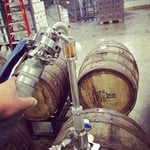 After I left Goose Island, I brewed at South Street Brewery, (which we acquired just as of summer 2014) from 2002-2007. I always did a bourbon stout, and we were, for a while, still only one of a few but now growing number of barrel-agers. When we opened Blue Mountain Brewery, it didn’t seem like some crazy thing to do, or some trendy hook, it was just something I’d personally always done in my brewing career. I built Dark Hollow around the way I was taught to do Bourbon County: a “sessionable” 10 percent or imperial stout. Back then, hitting 10 or 11 percent was still pretty big time.
After I left Goose Island, I brewed at South Street Brewery, (which we acquired just as of summer 2014) from 2002-2007. I always did a bourbon stout, and we were, for a while, still only one of a few but now growing number of barrel-agers. When we opened Blue Mountain Brewery, it didn’t seem like some crazy thing to do, or some trendy hook, it was just something I’d personally always done in my brewing career. I built Dark Hollow around the way I was taught to do Bourbon County: a “sessionable” 10 percent or imperial stout. Back then, hitting 10 or 11 percent was still pretty big time.
Fast forward to the 2010 Craft Brewers Conference in Chicago, and I was stunned to see how big Bourbon County had become. Thousands of bourbon barrels lined the walls of a new room at Goose Island’s Fulton production facility. It was wild. And since then, they’ve expanded across the street and their barrel-aging program is prolific and the envy of the world. It’s an honor to have learned bourbon barrel-aging beer from the source and to have passed it on to my teams of brewers at our three breweries. We’ve developed a sour program, played around with new styles and variants on existing styles, and generally just had fun with it and made some kick-ass beers. At the Barrel House especially, we put our own twist on everything we do — including barrel aging — and are proud to represent this take on the barrel-aging craft in our corner of the world.
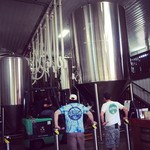 CBB: What efforts other than the brewing have gone into putting on this event?
CBB: What efforts other than the brewing have gone into putting on this event?
Beck: We had a three-pronged approach of Facebook, radio ads, and grass-roots flyer-posting. We published a separate event page on our Facebook page and have been boosting the posts to reach more beer lovers; we’ve played a rotation of ads over a two-week period on the local independent radio station that covers three of the larger nearby metro areas; and we’ve posted flyers at all three of our brewery locations (Blue Mountain Brewery, Blue Mountain Barrel House and South Street Brewery in Charlottesville, which we recently acquired). We’ve also had our brewers and salespeople hitting up beer forums.
The event itself has some elements that highlight and complement the beer: a great local band, rented outdoor tents for more space, and our hop horticulturalist—a Carolina boy—will be smoking two whole pigs and providing a buffet of sides for a really great price.
CBB: What kind of turnout do you expect? How are you gauging the value of your marketing dollars?
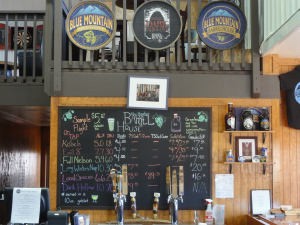 Beck: Obviously, we are hoping for the best possible turnout. I would drive — Hell, I would consider walking! — a couple hundred miles for this beer. We have taken a real grassroots approach on this event in order to extrapolate where to project next year’s marketing budget. We foresee this being a great opportunity to grow this annually, not only during the holiday season, but also to become a destination for the craft beer industry.
Beck: Obviously, we are hoping for the best possible turnout. I would drive — Hell, I would consider walking! — a couple hundred miles for this beer. We have taken a real grassroots approach on this event in order to extrapolate where to project next year’s marketing budget. We foresee this being a great opportunity to grow this annually, not only during the holiday season, but also to become a destination for the craft beer industry.

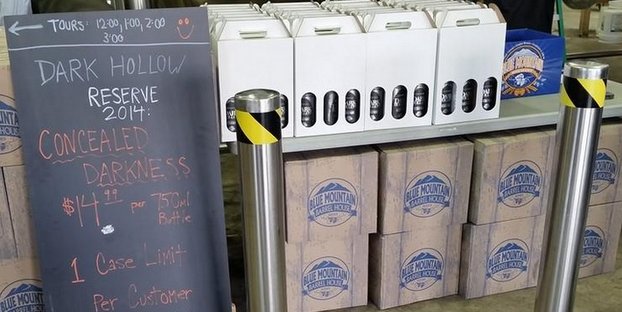
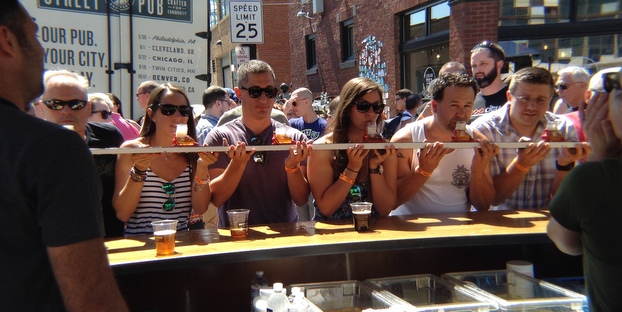

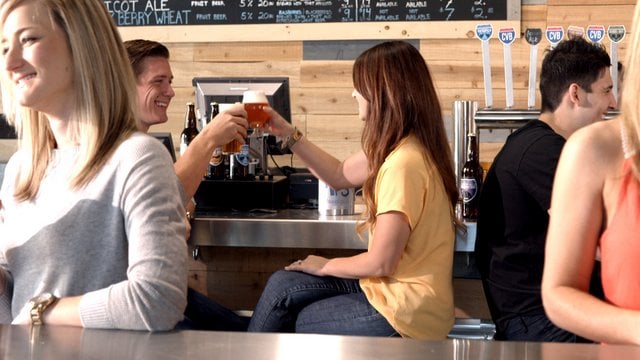
Blue Mountain Brewery shares event planning insight http://t.co/mrHHhx7DNo via @craftbrewingbiz
RT @CraftBrewingBiz: Before: Blue Mountain Brewery shares event planning insight:http://t.co/8fqVZ8hboJ @BlueMtnBrewery
Blue Mountain Brewery Shares Event Planning Insight http://t.co/0g36iIc5ry #brewery #events @BlueMtnBrewery #beer http://t.co/LCda5Dbg9e
Brew & Be Covered – Texas liked this on Facebook.
RT @CraftBrewingBiz: Before: Blue Mountain Brewery shares event planning insight:http://t.co/8fqVZ8hboJ @BlueMtnBrewery